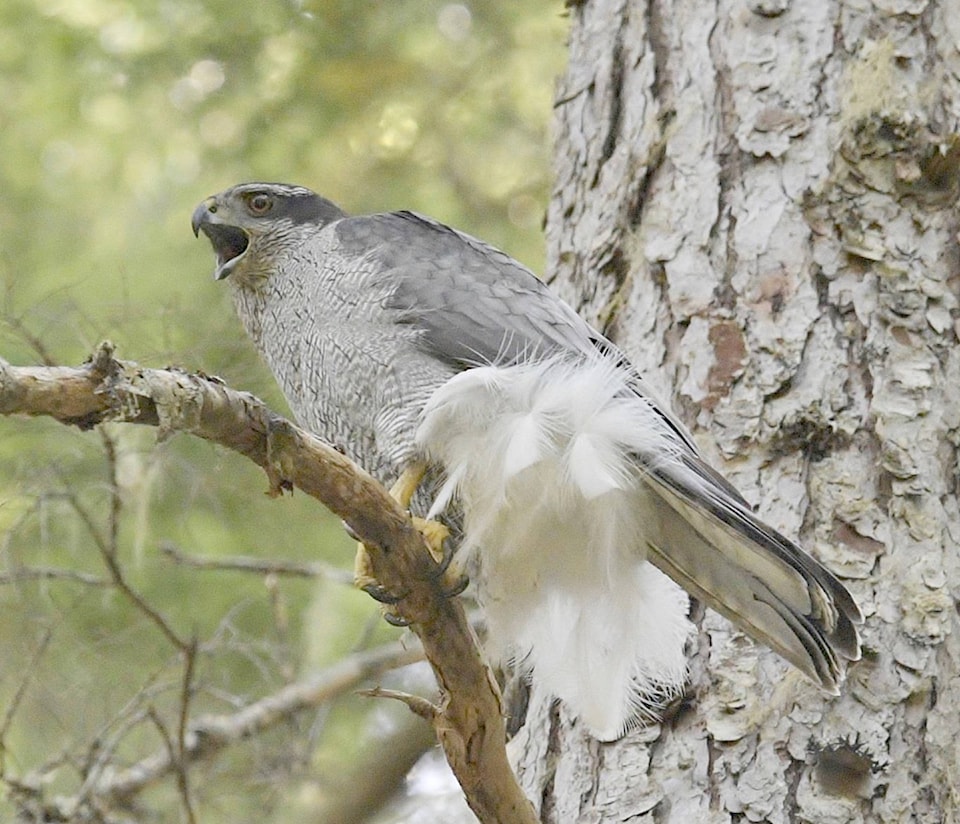More B.C. forest habitat will be set aside for marbled murrelet and coastal northern goshawk — Haida Gwaii’s national bird.
For marbled murrelet, a small seabird, the goal is to protect another 70,000 hectares of old-growth habitat, up from 750,000 hectares, all on southern Vancouver Island and the southern mainland.
For northern goshawk, the largest hawk in B.C., the target is to protect another 168 nesting areas in old-growth and mature forest, up from 240, with four of those nesting areas expected to be found on Haida Gwaii.
“These unique species of birds require mature and old-growth forest areas for breeding, and with their numbers declining, we need to do more to help them recover,” said Doug Donaldson, B.C.’s forests minister, announcing new recovery plans for the two at-risk species late last month.
The marbled murrelet plan does not include any new set-asides on Haida Gwaii or in the Great Bear Rainforest, where planners believe there is already enough protected old-growth forest for their recovery.
So far 21 nesting areas for coastal northern goshawk have been found and protected on the islands, where the Haida Gwaii land-use order requires a 200-hectare reserve around any identified nests.
Finding another four would bring the islands’ total to 25 — much less than the 58 nesting areas that a federal recovery strategy recommended for Haida Gwaii last year. The report said at least that many were needed to sustain a goshawk population big enough to avoid the harms of inbreeding.
Steve Gordon, manager of conservation and biodiversity for B.C.’s Ministry of Forests, Lands, Natural Resource Operations and Rural Development, said the province’s 25-area target was based on the likelihood of actually finding new nests here. The higher federal target is basically unachievable, he said.
“It represents the historical capacity of the entire archipelago,” said Gordon.
“A key principle is to make sure that we protect areas that are going to be effective in the long term, recognizing that when you do set aside areas there is an impact to the forest sector in particular. We want to make sure those conservation efforts are worthwhile.”
Finding northern goshawk nests on Haida Gwaii is a challenge. Crews with the Council of the Haida Nation heard a juvenile near Collison Point last year, but no new nests were found, and typically only one or two of the 21 known nests show any signs of breeding in a given year.
At least four goshawks were shot by islanders protecting their chickens last year, prompting the Haida Gwaii forestry office to offer free chicken-coop netting and owl decoys.
Some of the goshawks killed were juveniles, suggesting there are nests that haven’t been found yet. Province-wide, biologists estimate there are up to three times more goshawk nesting areas than the 240 that have been protected so far.
The new recovery plan for northern goshawk includes more research to understand the size and character of their much larger foraging habitats.
Gordon said it’s already obvious that introduced deer have dramatically lowered the number of creatures that goshawks prey on.
“That’s going to be a long-term management issue,” he said. “It’s one of the limiting factors that affects goshawk recovery there.”
Both recovery plans include more inventory work by provincial staff, but Gordon noted that the province also relies on the Haida Nation and forestry companies to identify habitat.
“They are the eyes and ears in the forest,” he said.
| Marbled murrelets are seabirds that lay a single egg each year on mossy platforms in old-growth forest. A new provincial recovery strategy for the threatened species calls for another 70,000 hectares of protected old-growth, up from 750,000, to try and stop their population from declining further. There are an estimated 72,000 to 125,000 left in coastal B.C. (Ministry of Forests, Lands, Natural Resource Operations and Rural Development) |
Unlike goshawks, which nest in mature as well as old-growth forests, marbled murrelets breed by laying a single egg in old-growth forests, often on a mossy platform.
“They only lay one egg per breeding season, and there’s a very low survival rate,” said Gordon, adding that marbled murrelets are better adapted for underwater swimming than flying, so they need wide-open forests to get between their nests and the sea. Until they hatch and fly away, their young are also very vulnerable to jays, crows, and ravens — all birds that typically follow logging activity.
“In the very first flight for that fledgling, they have to make it all the way from the old-growth to the ocean. If they fall on the ground, they can’t take off again.”
Besides a nest for courtship and breeding and their wider foraging range, northern goshawks keep a smaller “post-fledging” area for their young.
“What happens is when the young are learning to fly and hunt, the adults typically hunt farther away from the nest so they maintain a prey base near the nest,” Gordon said.
They also bring partially live prey sometimes,” he added.
“It is quite a life history.”
If anyone finds a northern goshawk or a goshawk nest on Haida Gwaii, they are encouraged to call the Haida Gwaii Natural Resource District at 250-559-6200.
Genetic samples from Haida Gwaii northern goshawks are also needed by UBC biologists, who are currently working on a genetic study co-funded by the province and forestry companies that will better define the boundary between coastal goshawks and the interior subspecies.
